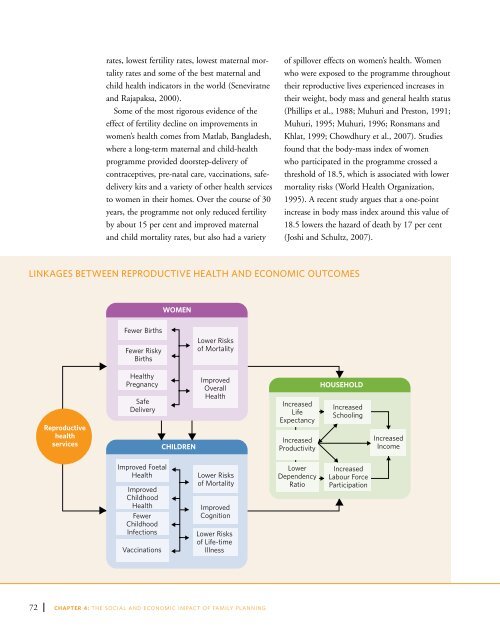State of World Population 2012 - Country Page List - UNFPA
State of World Population 2012 - Country Page List - UNFPA
State of World Population 2012 - Country Page List - UNFPA
Create successful ePaper yourself
Turn your PDF publications into a flip-book with our unique Google optimized e-Paper software.
ates, lowest fertility rates, lowest maternal mortality<br />
rates and some <strong>of</strong> the best maternal and<br />
child health indicators in the world (Seneviratne<br />
and Rajapaksa, 2000).<br />
Some <strong>of</strong> the most rigorous evidence <strong>of</strong> the<br />
effect <strong>of</strong> fertility decline on improvements in<br />
women’s health comes from Matlab, Bangladesh,<br />
where a long-term maternal and child-health<br />
programme provided doorstep-delivery <strong>of</strong><br />
contraceptives, pre-natal care, vaccinations, safedelivery<br />
kits and a variety <strong>of</strong> other health services<br />
to women in their homes. Over the course <strong>of</strong> 30<br />
years, the programme not only reduced fertility<br />
by about 15 per cent and improved maternal<br />
and child mortality rates, but also had a variety<br />
<strong>of</strong> spillover effects on women’s health. Women<br />
who were exposed to the programme throughout<br />
their reproductive lives experienced increases in<br />
their weight, body mass and general health status<br />
(Phillips et al., 1988; Muhuri and Preston, 1991;<br />
Muhuri, 1995; Muhuri, 1996; Ronsmans and<br />
Khlat, 1999; Chowdhury et al., 2007). Studies<br />
found that the body-mass index <strong>of</strong> women<br />
who participated in the programme crossed a<br />
threshold <strong>of</strong> 18.5, which is associated with lower<br />
mortality risks (<strong>World</strong> Health Organization,<br />
1995). A recent study argues that a one-point<br />
increase in body mass index around this value <strong>of</strong><br />
18.5 lowers the hazard <strong>of</strong> death by 17 per cent<br />
(Joshi and Schultz, 2007).<br />
Linkages between reproductive health and economic outcomes<br />
WOMEN<br />
Fewer Births<br />
Fewer Risky<br />
Births<br />
Lower Risks<br />
<strong>of</strong> Mortality<br />
Reproductive<br />
health<br />
services<br />
Healthy<br />
Pregnancy<br />
Safe<br />
Delivery<br />
CHILDREN<br />
Improved<br />
Overall<br />
Health<br />
Increased<br />
Life<br />
Expectancy<br />
Increased<br />
Productivity<br />
HOUSEHOLD<br />
Increased<br />
Schooling<br />
Increased<br />
Income<br />
Improved Foetal<br />
Health<br />
Improved<br />
Childhood<br />
Health<br />
Fewer<br />
Childhood<br />
Infections<br />
Vaccinations<br />
Lower Risks<br />
<strong>of</strong> Mortality<br />
Improved<br />
Cognition<br />
Lower Risks<br />
<strong>of</strong> Life-time<br />
Illness<br />
Lower<br />
Dependency<br />
Ratio<br />
Increased<br />
Labour Force<br />
Participation<br />
72 CHAPTER 4: THE SOCIAL AND ECONOMIC IMPACT OF FAMILY PLANNING
















